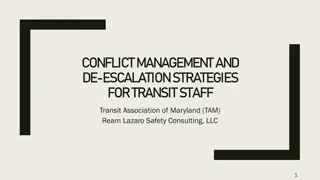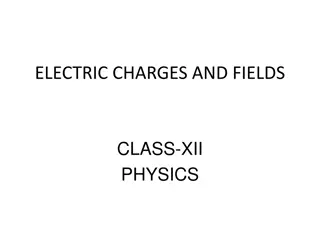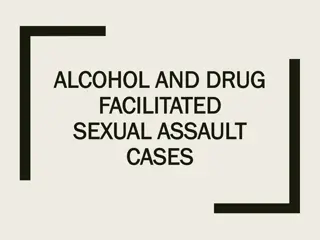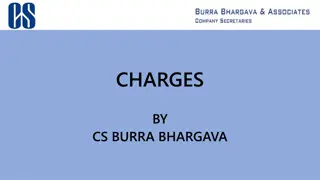Assault Charges
Explore the definition and statutory charges of assault. Learn about the physical and mental elements of assault, the relevance of violence apprehension, consent defenses, lawful assault scenarios, self-defense, and more. Gain insights into common assault charges and their impact on NSW courts.
Download Presentation

Please find below an Image/Link to download the presentation.
The content on the website is provided AS IS for your information and personal use only. It may not be sold, licensed, or shared on other websites without obtaining consent from the author.If you encounter any issues during the download, it is possible that the publisher has removed the file from their server.
You are allowed to download the files provided on this website for personal or commercial use, subject to the condition that they are used lawfully. All files are the property of their respective owners.
The content on the website is provided AS IS for your information and personal use only. It may not be sold, licensed, or shared on other websites without obtaining consent from the author.
E N D
Presentation Transcript
ASSAULT ASSAULT Tony Trichter APM Adjunct Industry Professor Charles Sturt University
In this lesson you will learn Definition of Assault and statutory Assault charges The physical and mental elements of Assault The relevance of apprehension of violence The difference between intent and recklessness When consent is no defence to an Assault charge Other defences to Assault: when an Assault is lawful When the defence of Self Defence is available When a Stalking/Intimidation charge is available The availability of Apprehended Violence Orders
Assault-related charges are the most common charges before NSW courts (almost 20,000 charges in 2018). The most common assault charges are: Common Assault Section 61 of the Crimes Act 1900 Assault Occasioning Actual Bodily Harm Section 59 Both offences may be dealt with summarily without the consent of the accused (ie, Table 2 offences). A substantial proportion of these charges arise out of domestic violence incidents.
An assault is any act committed, intentionally or recklessly, which: (a) causes another person to apprehend immediate and unlawful violence, or (b) consists of directly or indirectly striking, touching or applying force to another person, unlawfully or without the consent of the other person. . [Adapted from Halsbury s Laws of England] An assault can be committed by threat and gestures alone (ie, where there is no actual application of physical force) if the person being threatened apprehends immediate violence and the perpetrator has the present ability to carry out the threatened act. There needn t be any apprehension of violence in the case of application of unlawful violence (known as battery ).
An ASSAULT is an act which causes another person An ASSAULT is an act which causes another person to apprehend the infliction of immediate, unlawful to apprehend the infliction of immediate, unlawful force on his or her person. force on his or her person. A BATTERY is the actual infliction of unlawful force A BATTERY is the actual infliction of unlawful force on another person. on another person. Both ASSAULT and BATTERY constitute the offence of assault in NSW: English law treats them as separate and distinct.
Lets demonstrate with a scenario Let s demonstrate with a scenario Ralph is cruising the shopping centre car park, looking for a parking space. He sees an empty space and sets up to reverse into it when Claude drives into it front-first . A short time later, Ralph sees Claude inside the shopping centre and approaches him with the intention of remonstrating with him. He puts his hand on Claude s shoulder and says, You stole my parking space! Claude says, Get your hands off me! and attempts to walk away. Not satisfied, Ralph grabs Claude firmly by the arm and says, You re not going anywhere until you apologise .
A touch to draw attention is not an assault, as opposed to a touch to restrain where no legal power existed to restrain. Collins v Wilcock [1984] 3 All ER 374
Proofs of ASSAULT Proofs of ASSAULT (1) The accused (2) Struck, touched or applied force to another (battery), or threatened another with immediate violence (assault) (3) Intentionally or recklessly (4) Without consent (5) Without lawful excuse
Consider the following scenario: Mariah and Jenny play in opposing netball teams. There has been a fierce rivalry between them for many years. After a particularly fiery on-court encounter, Mariah approaches Jenny on the sideline at full time and says to her menacingly, If this were another time and place, I d break your face! Later that afternoon, Jenny is enjoying post game drinks at the pub when she receives a text message from Mariah stating, I know you re in here somewhere. I m coming to cut you up. Jenny looks around the pub and sees Mariah walking around with a broken beer bottle in her hand, seemingly looking here and there for her.
What are the issues to be considered? What are the issues to be considered? Conditional threat Conditional threat Tuberville v Savage (1669) 1 Mod Rep 3 but compare Police v Greaves [1964] NZLR 295 Apprehension of violence Apprehension of violence What evidence is required for a threat to amount to an assault? Immediacy of the threat Immediacy of the threat R v Mostyn (2004) 145 A Crim R 304 (NSWCCA)
R v Mostyn R v Mostyn The authorities are clear that a threat to strike a person even at such a distance as to make contact impossible may constitute an assault if it instils a fear of immediate violence in the mind of the hearer.
A threat over the telephone? A threat over the telephone? See John Adrian Knight (1988) 35 A Crim R 314 and Barton v Armstrong [1969] 2 NSWLR 451 The test is whether, having regard to all of the circumstances in which the threat is made, the threat is one of immediate violence: ie, is such as to cause the victim to apprehend immediate violence. In those circumstances, the threat is not mere words .
So, what if the element of So, what if the element of IMMEDIACY IMMEDIACY is absent? is absent? Consider the offence of Stalking/Intimidation - Section 13 of the Crimes (Domestic and Personal Violence) Act 2007 This offence fills the gap created by the requirement of immediacy. The offence is committed if the accused stalks or intimidates another person: (a) with the intention of causing the other person to fear physical or mental harm to themselves or to a person with whom the person has a domestic relationship, or (b) knowing their conduct is likely to cause fear in the other person. Note that it need not be proved that the person actually feared physical or mental harm.
The scenario continues The scenario continues Mariah sees Jenny across the room and yells, Hey Jenny, cop this! Mariah then hurls the broken bottle towards Jenny. The bottle narrowly misses Jenny s head and instead it hits Steve the Bouncer on the cheek, causing a large graze that bleeds, as well as swelling and soreness that lasts for a week. Mariah picks up another bottle, smashes it on the bar and runs towards Jenny, who tries to run away but trips on a bar stool and falls down a short flight of stairs, fracturing two of her ribs. Mariah is then restrained by Steve the Bouncer. As a result of the incident, Jenny develops a serious case of post- traumatic stress, including anxiety, insomnia and depression.
What are the issues to be considered? What are the issues to be considered? Transferred malice Injury occurring in an attempt to evade a threat What does Steve s injury amount to? What do Jenny s injuries amount to? What if Mariah claims she didn t intend the bottle to hit anyone? Recklessness?
Transferred malice If A intends to assault B but, in attempting to do so, assaults C, then A s intent (or malice) is said to have transferred to C, so that A is therefore guilty of assaulting C. See McBride v Turnock 1964 CLR 456, in which a police officer was accidentally struck by the accused, who was swinging punches at a third person.
Injured while attempting to escape an assault Injured while attempting to escape an assault It has been held that if a person is injured as a direct result of attempting to escape from a reasonable apprehension of an assault, the person who is the cause of the apprehension (the accused) may be guilty of AOABH. R v Grimes 10 WN 211 R v Beech 7 CAR 197 R v Lewis [1970] Crim. L.R. 647 Example: To escape from a reasonable apprehension of an assault by the accused, a woman jumped out of a window and was injured. The accused was found guilty of assault (R v Grimes).
Actual Bodily Harm Actual Bodily Harm and Wounding Wounding Actual Bodily Harm requires that there be an actual bodily injury, which is more than merely transient or trifling. Bruises and scratches are typical examples of actual bodily harm: McIntyre v R (2009) 198 A Crim R 549. The offence does not require proof that the accused intended to inflict actual bodily harm only that the accused intended to apply unlawful force ie, to commit an assault (or was reckless as to its application): R v Percali (1986) 42 SASR 46. An assault which causes a very serious psychological injury or a hysterical and nervous condition amounts to an assault occasioning actual bodily harm: See Li v R [2005] NSWCCA 442; R v Chan-Fook [1994] 2 All ER 552; R v Miller [1954] 38 C.A.R. 1. For assaults that result in a wound, see sections 33 (wound with intent) and 35 (reckless wounding) of the Crimes Act 1900. To constitute a wound, the continuity of the skin must be broken and the injury must bleed.
Intent Intent and Recklessness Recklessness Intent requires that the accused intended the kind of harm in fact done the intent to bring about the result. Recklessness requires proof of the realisation on the part of the accused of the possible consequences of the act ie, the accused committed the act which brought about the harm with foresight of the possible consequences of that act. The test of recklessness is a SUBECTIVE test. Where a person is accused of inflicting a wound or causing grievous bodily harm and recklessness is relied on, the prosecution must prove the accused had the foresight of the possibility of causing actual bodily harm (as amended by the Crimes Amendment (Reckless Infliction of Harm) Act 2012, remedying Blackwell v R).
The scenario concludes The scenario concludes Mariah s brother Mike returns to the pub the next night, with the intent of getting even with Steve the Bouncer for restraining his sister. Mike challenges Steve to a fight, which Steve accepts. They step out into the car park and Mike takes Steve by surprise with a tackle that puts Steve on the ground. As a result, Steve sustains some scratches and bruising. Steve, a kickboxing champion, gets up and quickly overpowers Mike with a flurry of punches. Among other injuries, Mike suffers a fractured eye socket. Mike shouts, Enough! You win and runs back into the pub. Steve runs after him. Inside the pub, Mike picks up a metal bar stool and rushes at Steve. He smashes Steve over the head, fracturing Steve s skull.
What are the issues to be considered? What are the issues to be considered? What do the combatants injuries amount to? Is CONSENT a defence where the parties engage in a fight willingly? Is the defence of SELF DEFENCE available to either party?
Grievous Bodily Harm Grievous Bodily Harm A bodily injury of a really serious kind : DPP v Smith [1961] AC 290. Also defined in section 4 of the Crimes Act 1900: (a) the destruction (other than in the course of a medical procedure or a termination of a pregnancy in accordance with the Abortion Law Reform Act 2019) of the foetus of a pregnant woman, whether or not the woman suffers any other harm, and (b) any permanent or serious disfiguring of the person, and (c) any grievous bodily disease (in which case a reference to the infliction of grievous bodily harm includes a reference to causing a person to contract a grievous bodily disease)
Consent Consent Consent, by the person assaulted, may make lawful an act of physical force to the person of another. Consent cannot be a defence to a charge of assault where the alleged assault consists of an unlawful act. To strike another person with such a degree of violence that bodily harm is a probable consequence is an unlawful act. R v Brown [1994] AC 212 is authority for the proposition that you cannot consent to an assault that would constitute actual bodily harm. Those who enter into a consensual fight are guilty of assault if they intend to inflict bodily harm (Also see slide below).
The defence of SELF DEFENCE The defence of SELF DEFENCE Section 418 of the Crimes Act 1900: 418 Self-defence when available (1) A person is not criminally responsible for an offence if the person carries out the conduct constituting the offence in self-defence. (2) A person carries out conduct in self-defence if and only if the person believes the conduct is necessary: (a) to defend himself or herself or another person, or (b) to prevent or terminate the unlawful deprivation of his or her liberty or the liberty of another person, or (c) To protect property from unlawful taking, destruction, damage or interference, or (d) To prevent criminal trespass to any land or premises or to remove a person committing any such criminal trespass, and the conduct is a reasonable response in the circumstances as he or she perceives them.
How to apply the legal test in practice How to apply the legal test in practice 1. Self-defence is a defence to assault: The law recognises the right of a person to act in self-defence from an attack or threatened attack. 2. The prosecution bears the onus of proof: It is for the prosecution to eliminate it as an issue by proving beyond reasonable doubt that the accused s act was not done in self-defence. 3. It is a twofold test: The prosecution may do this by proving beyond reasonable doubt either: (a)the accused did not believe at the time of the act that it was necessary to do what he or she did in order to defend himself or herself (the SUBJECTIVE part); or (b)the accused s act was not a reasonable response in the circumstances as he or she perceived them (the OBJECTIVE part).
Now, lets examine the two Now, let s examine the two- -part test more closely part test more closely The SUBJECTIVE part: In determining the issue of whether the accused personally believed that his or her conduct was necessary for self-defence, the jury must consider the circumstances as the accused perceived them to be at the time. If the accused did not believe the conduct to be necessary in self-defence, then the defence of self-defence will not be available.
The OBJECTIVE part: If the jury is not satisfied beyond reasonable doubt that the accused did not personally believe that his or her conduct was necessary for self-defence, it must then decide whether the prosecution has proved beyond reasonable doubt that the conduct of the accused was not a reasonable response to the circumstances as perceived by him or her. If the prosecution fails to do so it will have failed to eliminate self-defence. The second part of the test is an objective one, based on the circumstances as perceived by the accused. It is the circumstances as perceived by the accused that are important, and it does not matter if the accused was mistaken about a fact which would have otherwise changed their mind. It is only those facts as known by the accused at the time of the act that are to be assessed objectively!
Is self Is self- -defence available to a person who willingly defence available to a person who willingly enters into a fight? enters into a fight? A person who starts a fight, or enters into one willingly, with another person (as opposed to a circumstance of self-defence by using a pre- emptive strike in anticipation of an assault from the other person) cannot be acting in self-defence. You cannot be acting in self-defence if you started or proviked the fight or consented to it. See R v Nguyen (1995) NSWLR 397 However! See also Zecevic v DPP (1987) 162 CLR 645
Zecevic Zecevic v DPP v DPP Where an accused person raising a plea of self-defence was the original aggressor and induced or provoked the assault against which he claims the right to defend himself, it will be for the jury to consider whether the original aggression had ceased so as to have enabled the accused to form a belief, upon reasonable grounds, that his actions were necessary in self defence. For this purpose, it will be relevant to consider the extent to which the accused declined further conflict and quit the use of force or retreated from it
Some other Some other LAWFUL EXCUSES LAWFUL EXCUSES to an Assault to an Assault Lawful correction See section 61AA of the Crimes Act 1900 Defence of another, defence of property, etc. See s.418(2) Lawful arrest, and execution of process and sentence Medical examination of persons in custody Non-intentional / negligent application of physical force (but see Fagan v Commissioner of Metropolitan Police [1968] 3 All ER 442) When consented to (including lawful sports played within the rules)
What if a person fears violence by another at some future time? Consider an Apprehended Violence Order (AVO) Crimes (Domestic and Personal Violence) Act 2007 A court may, on application, make an apprehended violence order if it is satisfied on the balance of probabilities that a person has reasonable grounds to fear and in fact fears* an offence of violence or stalking or intimidation. For Apprehended Domestic Violence Orders, see s.16. For Apprehended Personal Violence Orders, see s.19. * There are some circumstances in which the court need not be satisfied the person for whose protection the order is sought in fact fears see s.16(2) & 19(2)
Other assault Other assault- -related offences under the NSW Crimes Act related offences under the NSW Crimes Act Assault is a building block offence per the Crimes Act, in that the Act provides a range of assault-related offences of varying penalties according to such matters (aggravating factors) as: the kind of victim (eg, police officers, ambulance officers, etc.) the degree of intent (eg, compare sections 33 and 35) the nature of the injury inflicted (from no injury the grievous bodily harm) whether committed alone or in company In what circumstances the assault was committed (eg, assaults during public disorder, assaults in schools). Is the statutory scheme for assault offences in need of overhaul? DISCUSS!























